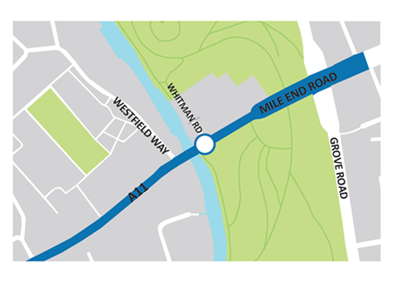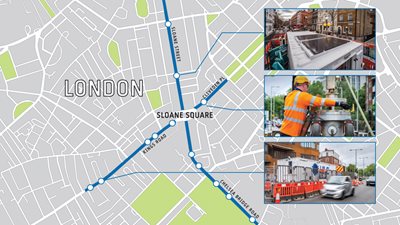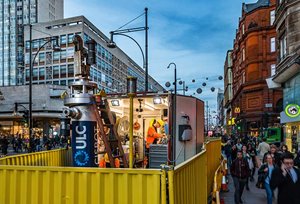The Cast Iron Joint Sealing Robot (CISBOT) is a remotely controlled robot which we are using to repair and upgrade gas pipes in some of the busiest streets across our networks.

The CISBOT, developed by our partners ULC Robotics, works by ‘crawling’ along the inside of a gas main, sealing any leaks in the joints using a special sealant solution. It allows road users and pedestrians to get on with their busy lives, as the robot can cover large sections of gas pipe underground from just a single hole (the 'launch' point) in the ground.
Watch this short video to find out more about how CISBOT works, and read about some of our major works using CISBOT below.

During the festive period in 2020, we carried out essential work on the historic streets of Whitechapel in conjunction with Thames Water, to futureproof local gas and water supplies. With support from the Greater London Authority and Transport for London (TfL), we delivered a low disruption programme of work by using ULC’s robotic technology to remediate a 150 metre section of pipeline.
CISBOT provided us with a reliable solution to extend the life of by a minimum of 50 years, saving future disruption and providing significant cost savings. The use of CISBOT and ULC’s 24 hour work at Whitechapel minimised the need for multiple excavations, resulting in saving 18 days of disruption to the area.

Our works in Whitehall were the first time we've used CISBOT to carry out emergency repairs. We were working in close proximity to Trafalgar Square – one of London’s top tourist attractions with up to 15 million annual visitors.
Seeing an opportunity to use technology to minimise disruption, we collaborated with ULC
Pipeline Robotics, Transport for London and the local council to deploy CISBOT to conduct key segments of the emergency repair work.
ULC Robotics stepped in at short notice to support the repair work, successfully remediating 359 meters of our 30” low pressure gas pipes and sealing 105 joints using CISBOT technology.

We remediated more than 1,300 joints using CISBOT in Sloane Square throughout 2020, after gaining significant support from Kensington and Chelsea Borough Council. The project was completed in 44 weeks – an 80% reduction in the time traditional works would have taken.
The Sloane Square project involved 8 phases where CISBOT was deployed in almost
20 pits around the streets located off Sloane Square, working on 18”, 20”, 24” and 36”
diameter mains. Due to the high-profile and potentially disruptive locations of work
surrounding Sloane Square, ULC Robotics strategically positioned their launch locations
to ensure that traffic lanes and lights were still in use on any major bus routes and that
minimal disruption was caused to members of the public and road users.

The task: Upgrade a 675m section of 24” cast iron main and eliminate ongoing gas leaks, from Trafalgar Square to Aldwych
Duration: 7 weeks
Cadent engineers were working close to The Strand, undertaking emergency gas works. ULC Robotics stepped in at short notice to support.
CISBOT successfully upgraded a total of 185 joints across the 675m section of 24” main.
All gas leaks were successfully eliminated, including one outside the busy Waterloo Bridge junction - all the while maintaining access for road users.

The task: Upgrade 1.3km of 18” cast iron pipe
Duration: 12 weeks
Following the successful trial at The Strand, local authorities granted permission to undertake this project within a matter of days. CISBOT successfully upgraded a total of 357 joints across the 1.3km of cast iron main.
The work prevented a gas leak that could have resulted in 700 people being evacuated from their workplace.
4 million people per week walk up and down Oxford Street. Those pedestrians and the local highways were never at all impacted during the operation.